air suspension TOYOTA GT86 2013 Owners Manual (in English)
[x] Cancel search | Manufacturer: TOYOTA, Model Year: 2013, Model line: GT86, Model: TOYOTA GT86 2013Pages: 448, PDF Size: 13.47 MB
Page 121 of 448
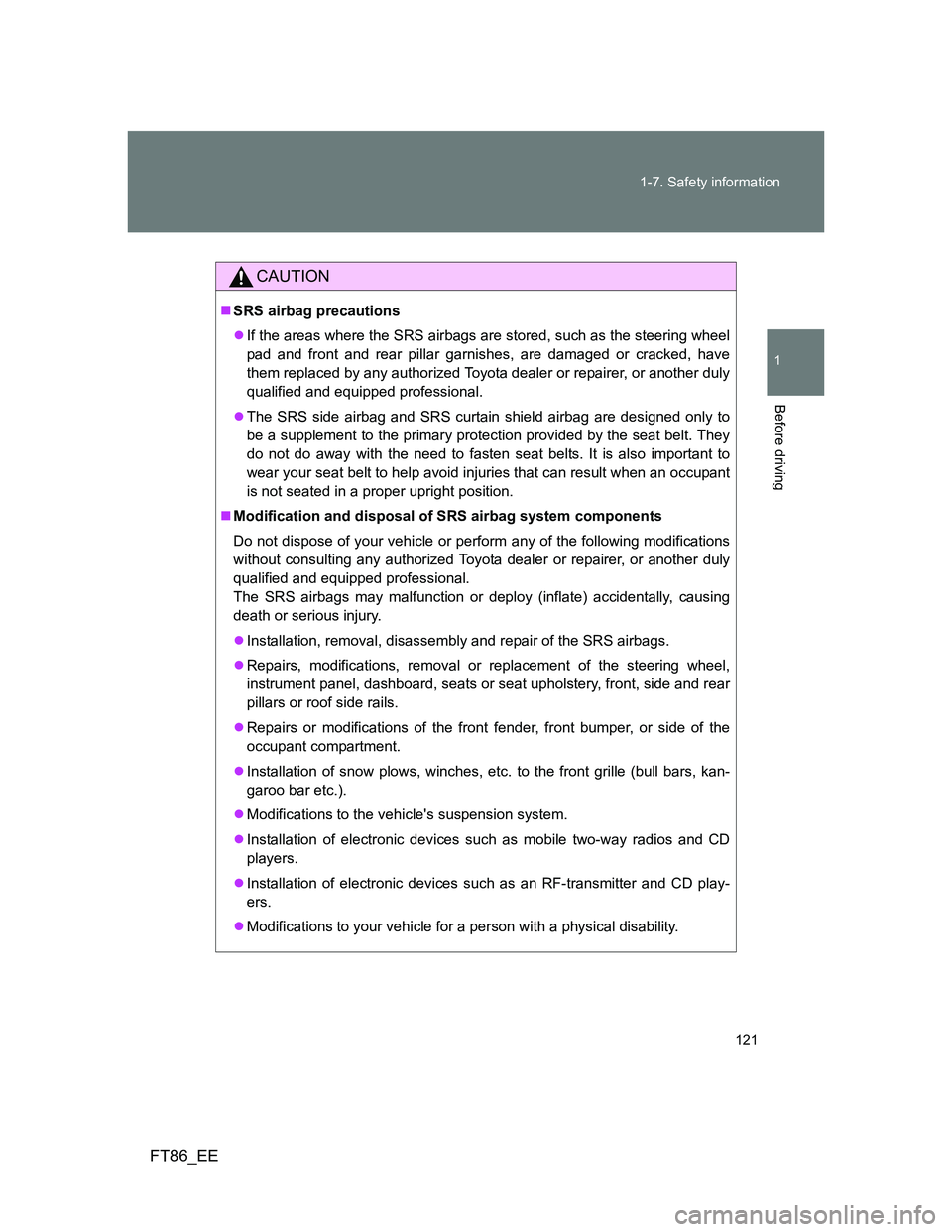
121 1-7. Safety information
1
Before driving
FT86_EE
CAUTION
SRS airbag precautions
If the areas where the SRS airbags are stored, such as the steering wheel
pad and front and rear pillar garnishes, are damaged or cracked, have
them replaced by any authorized Toyota dealer or repairer, or another duly
qualified and equipped professional.
The SRS side airbag and SRS curtain shield airbag are designed only to
be a supplement to the primary protection provided by the seat belt. They
do not do away with the need to fasten seat belts. It is also important to
wear your seat belt to help avoid injuries that can result when an occupant
is not seated in a proper upright position.
Modification and disposal of SRS airbag system components
Do not dispose of your vehicle or perform any of the following modifications
without consulting any authorized Toyota dealer or repairer, or another duly
qualified and equipped professional.
The SRS airbags may malfunction or deploy (inflate) accidentally, causing
death or serious injury.
Installation, removal, disassembly and repair of the SRS airbags.
Repairs, modifications, removal or replacement of the steering wheel,
instrument panel, dashboard, seats or seat upholstery, front, side and rear
pillars or roof side rails.
Repairs or modifications of the front fender, front bumper, or side of the
occupant compartment.
Installation of snow plows, winches, etc. to the front grille (bull bars, kan-
garoo bar etc.).
Modifications to the vehicle's suspension system.
Installation of electronic devices such as mobile two-way radios and CD
players.
Installation of electronic devices such as an RF-transmitter and CD play-
ers.
Modifications to your vehicle for a person with a physical disability.
Page 164 of 448
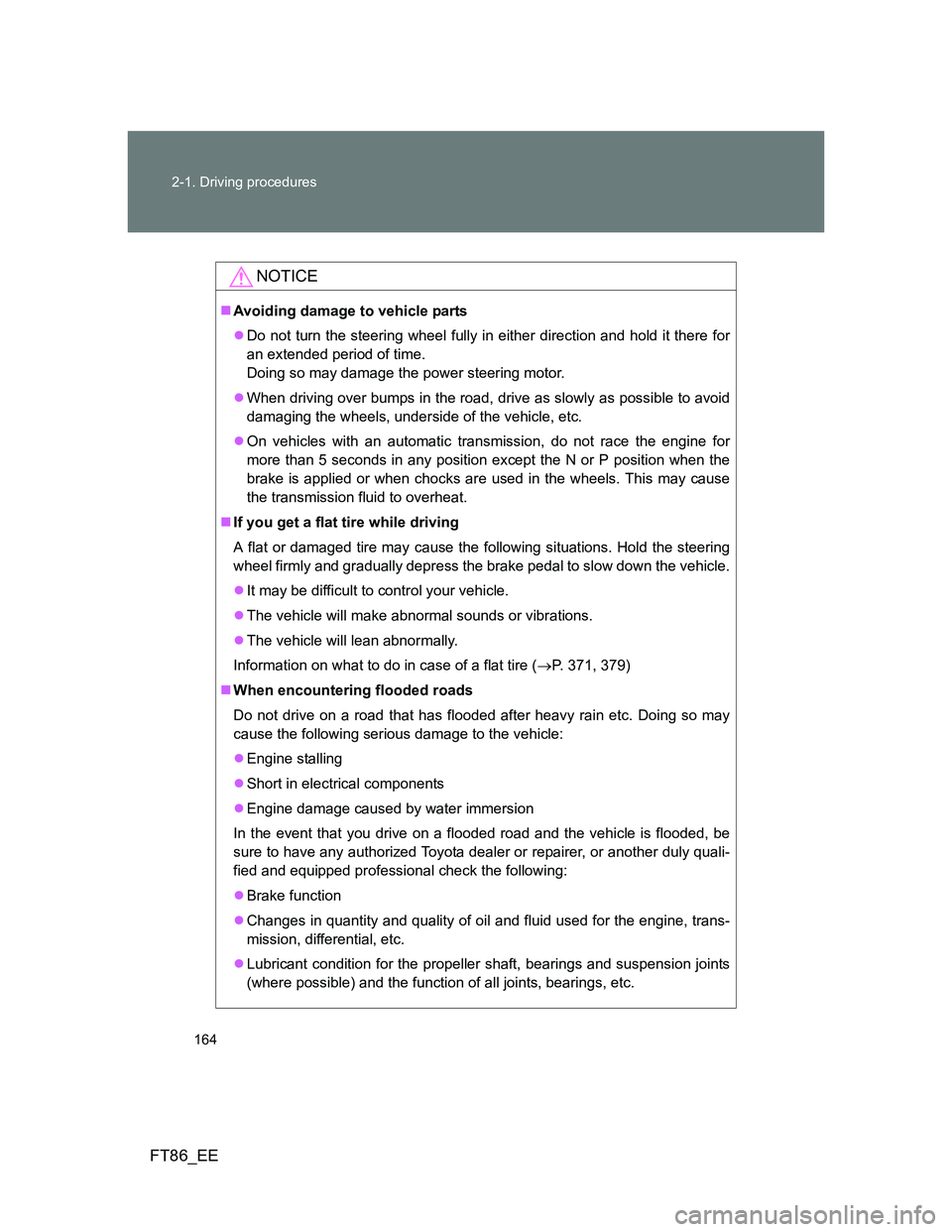
164 2-1. Driving procedures
FT86_EE
NOTICE
Avoiding damage to vehicle parts
Do not turn the steering wheel fully in either direction and hold it there for
an extended period of time.
Doing so may damage the power steering motor.
When driving over bumps in the road, drive as slowly as possible to avoid
damaging the wheels, underside of the vehicle, etc.
On vehicles with an automatic transmission, do not race the engine for
more than 5 seconds in any position except the N or P position when the
brake is applied or when chocks are used in the wheels. This may cause
the transmission fluid to overheat.
If you get a flat tire while driving
A flat or damaged tire may cause the following situations. Hold the steering
wheel firmly and gradually depress the brake pedal to slow down the vehicle.
It may be difficult to control your vehicle.
The vehicle will make abnormal sounds or vibrations.
The vehicle will lean abnormally.
Information on what to do in case of a flat tire (P. 371, 379)
When encountering flooded roads
Do not drive on a road that has flooded after heavy rain etc. Doing so may
cause the following serious damage to the vehicle:
Engine stalling
Short in electrical components
Engine damage caused by water immersion
In the event that you drive on a flooded road and the vehicle is flooded, be
sure to have any authorized Toyota dealer or repairer, or another duly quali-
fied and equipped professional check the following:
Brake function
Changes in quantity and quality of oil and fluid used for the engine, trans-
mission, differential, etc.
Lubricant condition for the propeller shaft, bearings and suspension joints
(where possible) and the function of all joints, bearings, etc.
Page 226 of 448
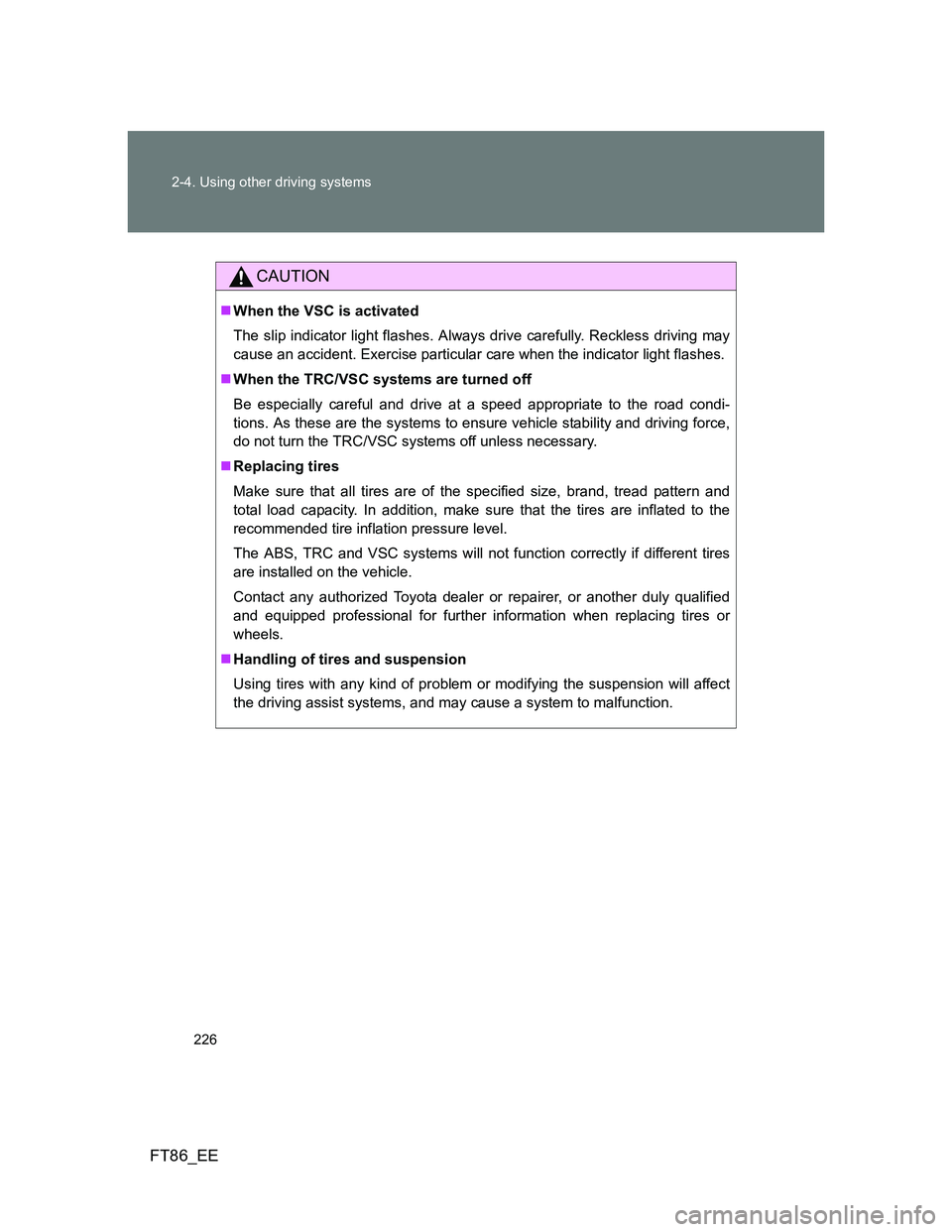
226 2-4. Using other driving systems
FT86_EE
CAUTION
When the VSC is activated
The slip indicator light flashes. Always drive carefully. Reckless driving may
cause an accident. Exercise particular care when the indicator light flashes.
When the TRC/VSC systems are turned off
Be especially careful and drive at a speed appropriate to the road condi-
tions. As these are the systems to ensure vehicle stability and driving force,
do not turn the TRC/VSC systems off unless necessary.
Replacing tires
Make sure that all tires are of the specified size, brand, tread pattern and
total load capacity. In addition, make sure that the tires are inflated to the
recommended tire inflation pressure level.
The ABS, TRC and VSC systems will not function correctly if different tires
are installed on the vehicle.
Contact any authorized Toyota dealer or repairer, or another duly qualified
and equipped professional for further information when replacing tires or
wheels.
Handling of tires and suspension
Using tires with any kind of problem or modifying the suspension will affect
the driving assist systems, and may cause a system to malfunction.
Page 232 of 448
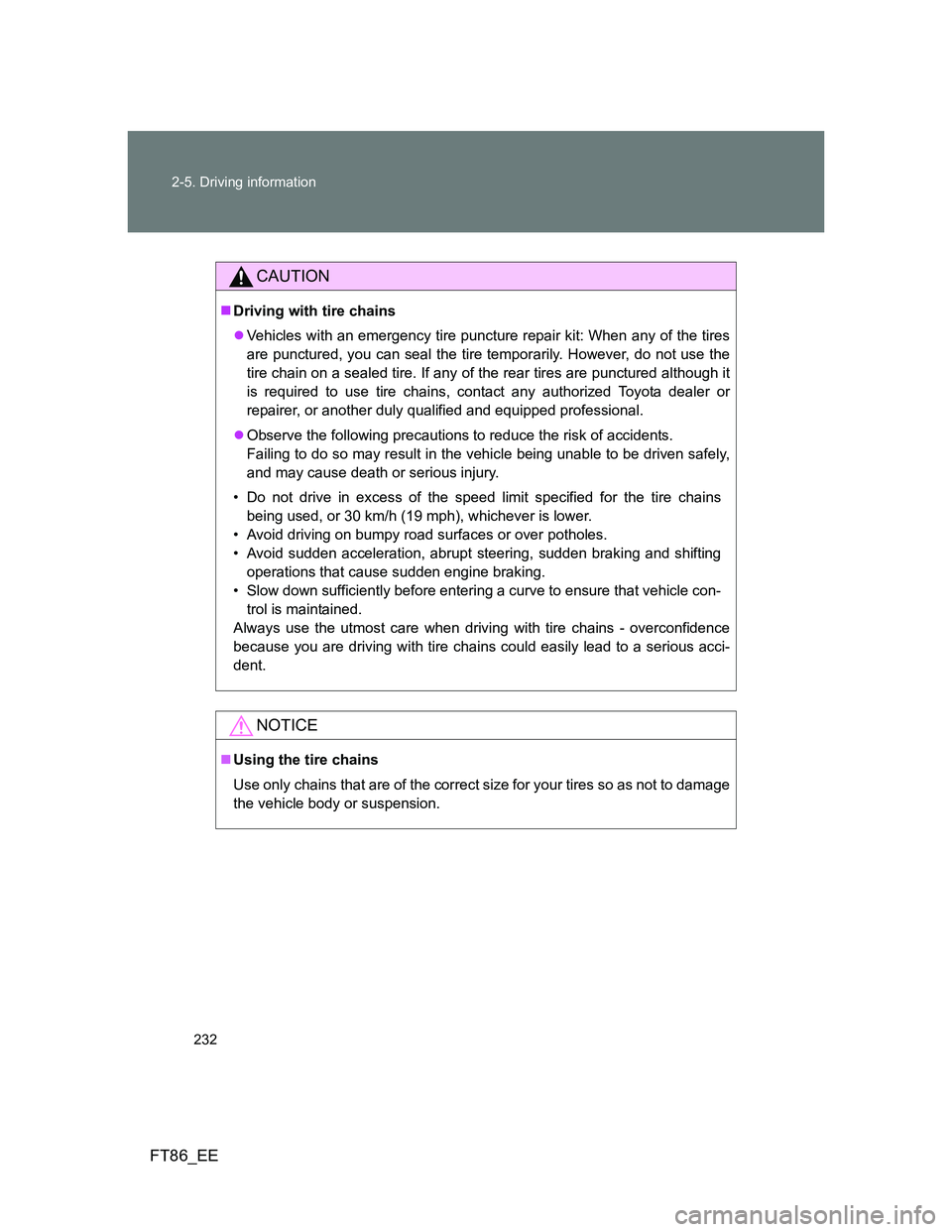
232 2-5. Driving information
FT86_EE
CAUTION
Driving with tire chains
Vehicles with an emergency tire puncture repair kit: When any of the tires
are punctured, you can seal the tire temporarily. However, do not use the
tire chain on a sealed tire. If any of the rear tires are punctured although it
is required to use tire chains, contact any authorized Toyota dealer or
repairer, or another duly qualified and equipped professional.
Observe the following precautions to reduce the risk of accidents.
Failing to do so may result in the vehicle being unable to be driven safely,
and may cause death or serious injury.
• Do not drive in excess of the speed limit specified for the tire chains
being used, or 30 km/h (19 mph), whichever is lower.
• Avoid driving on bumpy road surfaces or over potholes.
• Avoid sudden acceleration, abrupt steering, sudden braking and shifting
operations that cause sudden engine braking.
• Slow down sufficiently before entering a curve to ensure that vehicle con-
trol is maintained.
Always use the utmost care when driving with tire chains - overconfidence
because you are driving with tire chains could easily lead to a serious acci-
dent.
NOTICE
Using the tire chains
Use only chains that are of the correct size for your tires so as not to damage
the vehicle body or suspension.
Page 289 of 448
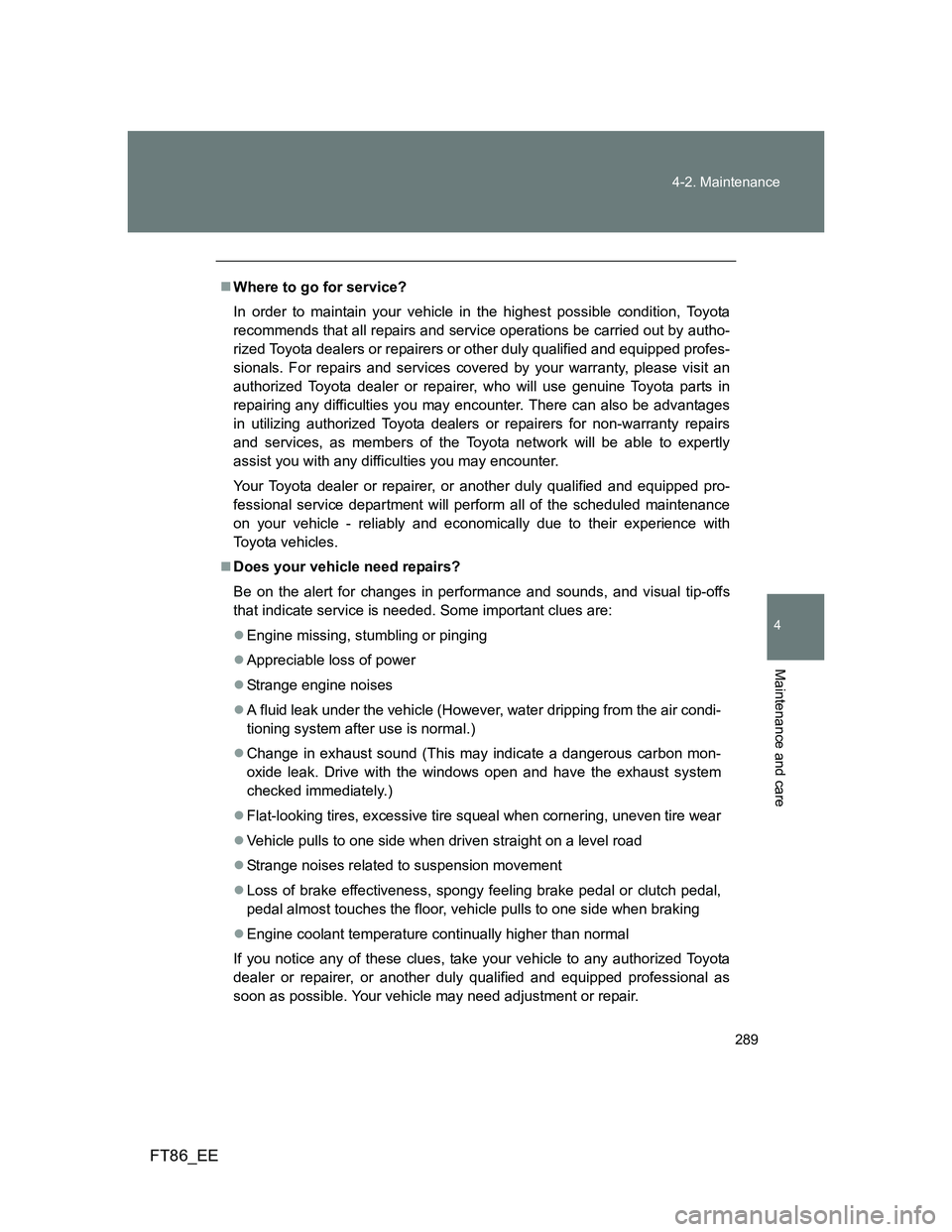
289 4-2. Maintenance
4
Maintenance and care
FT86_EE
Where to go for service?
In order to maintain your vehicle in the highest possible condition, Toyota
recommends that all repairs and service operations be carried out by autho-
rized Toyota dealers or repairers or other duly qualified and equipped profes-
sionals. For repairs and services covered by your warranty, please visit an
authorized Toyota dealer or repairer, who will use genuine Toyota parts in
repairing any difficulties you may encounter. There can also be advantages
in utilizing authorized Toyota dealers or repairers for non-warranty repairs
and services, as members of the Toyota network will be able to expertly
assist you with any difficulties you may encounter.
Your Toyota dealer or repairer, or another duly qualified and equipped pro-
fessional service department will perform all of the scheduled maintenance
on your vehicle - reliably and economically due to their experience with
Toyota vehicles.
Does your vehicle need repairs?
Be on the alert for changes in performance and sounds, and visual tip-offs
that indicate service is needed. Some important clues are:
Engine missing, stumbling or pinging
Appreciable loss of power
Strange engine noises
A fluid leak under the vehicle (However, water dripping from the air condi-
tioning system after use is normal.)
Change in exhaust sound (This may indicate a dangerous carbon mon-
oxide leak. Drive with the windows open and have the exhaust system
checked immediately.)
Flat-looking tires, excessive tire squeal when cornering, uneven tire wear
Vehicle pulls to one side when driven straight on a level road
Strange noises related to suspension movement
Loss of brake effectiveness, spongy feeling brake pedal or clutch pedal,
pedal almost touches the floor, vehicle pulls to one side when braking
Engine coolant temperature continually higher than normal
If you notice any of these clues, take your vehicle to any authorized Toyota
dealer or repairer, or another duly qualified and equipped professional as
soon as possible. Your vehicle may need adjustment or repair.
Page 360 of 448
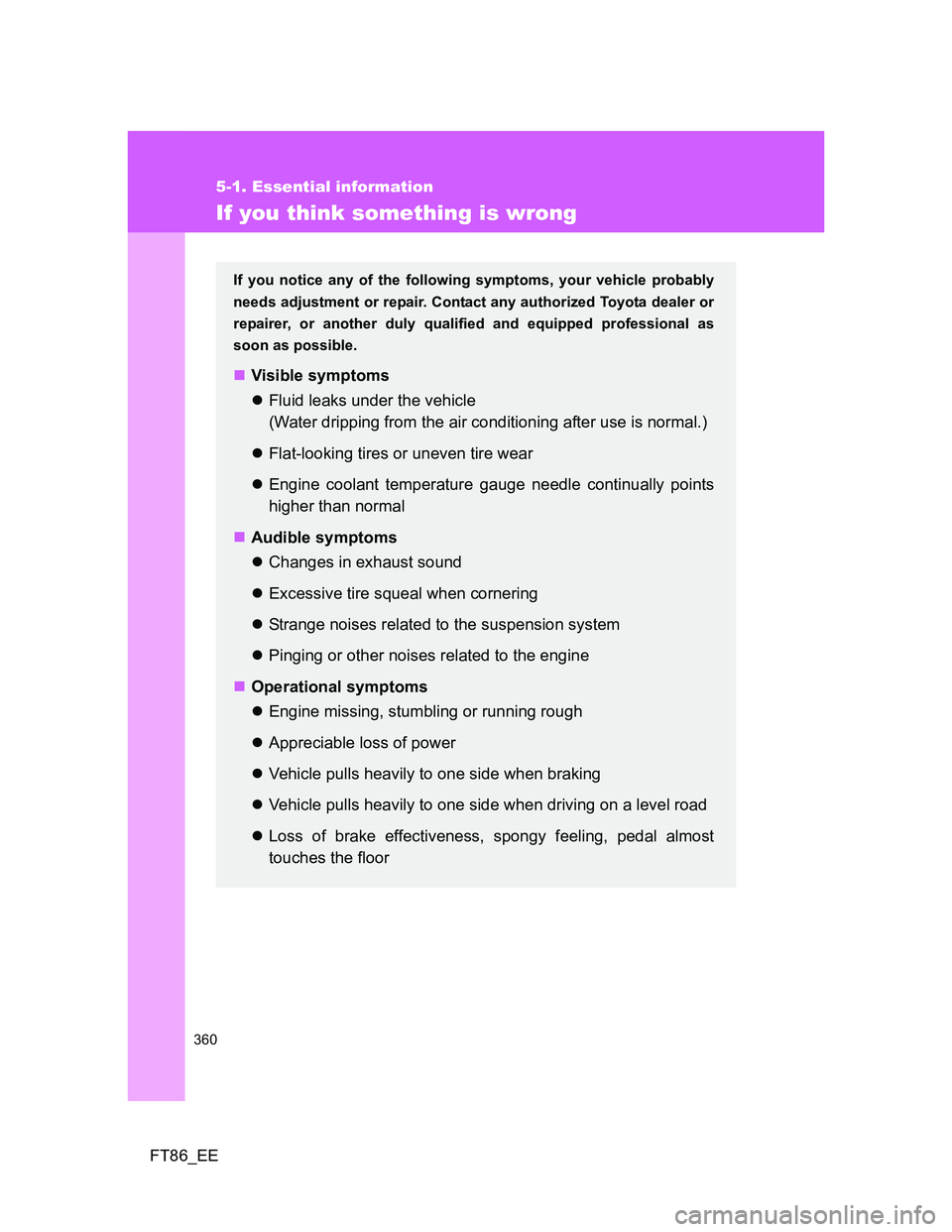
360
5-1. Essential information
FT86_EE
If you think something is wrong
If you notice any of the following symptoms, your vehicle probably
needs adjustment or repair. Contact any authorized Toyota dealer or
repairer, or another duly qualified and equipped professional as
soon as possible.
Visible symptoms
Fluid leaks under the vehicle
(Water dripping from the air conditioning after use is normal.)
Flat-looking tires or uneven tire wear
Engine coolant temperature gauge needle continually points
higher than normal
Audible symptoms
Changes in exhaust sound
Excessive tire squeal when cornering
Strange noises related to the suspension system
Pinging or other noises related to the engine
Operational symptoms
Engine missing, stumbling or running rough
Appreciable loss of power
Vehicle pulls heavily to one side when braking
Vehicle pulls heavily to one side when driving on a level road
Loss of brake effectiveness, spongy feeling, pedal almost
touches the floor